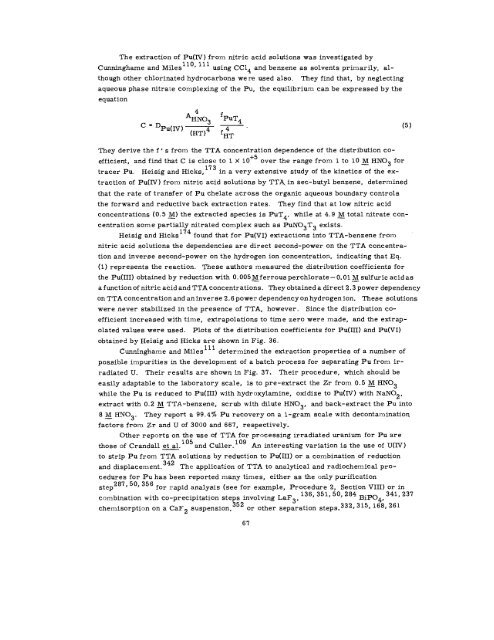THE RADIOCHEMISTRY OF PLUTONIUM - Sciencemadness.org
THE RADIOCHEMISTRY OF PLUTONIUM - Sciencemadness.org
THE RADIOCHEMISTRY OF PLUTONIUM - Sciencemadness.org
You also want an ePaper? Increase the reach of your titles
YUMPU automatically turns print PDFs into web optimized ePapers that Google loves.
The extraction of Pu(IV ) from nitric acid solutions was investigated by<br />
Cunninghsme and Miles 110’ 111 using CC14 and benzene as solvents primarily, al -<br />
though other chlorinated hydrocarbons were used also. They find that, by neglecting<br />
aqueous phase nitrate completing of the Pu, the equilibrium can be expressed by the<br />
equation<br />
c = DPU(IV)<br />
4<br />
‘HN03<br />
‘PuT4<br />
(HT)4 f~T<br />
They derive the f‘ s from the TTA concentration dependence of the distribution co-<br />
efficient, and find that C is close to 1 X 10+5 over the range from 1 to 10 ~ HN03 for<br />
tracer Pu. Heisig and Hicks, 173 m a very extensive study of the kinetics of the ex-<br />
traction of Pu(IV ) from nitric acid solutions by TTA, in sec-butyl benzene, determined<br />
that the rate of transfer of Pu chelate across the <strong>org</strong>anic aqueous boundary controls<br />
the forward and reductive back extraction rates. They find that at low nitric acid<br />
concentrations (O. 5 ~) the extracted species is PuT4, while at 4.9 M total nitrate con-<br />
—<br />
centration some partially nitrated complex such as PuN03T3 exists.<br />
Heisig and Hicks 174 found that for Pu(VI) extractions into TTA-benzene from<br />
nitric acid solutions the dependencies are direct second-power on the TTA concentra-<br />
tion and inverse second-power on the hydrogen ion concentration, indicating that Eq.<br />
(1) represents the reaction. These authors measured the distribution coefficients for<br />
the Pu(III) obtained by reduction with 0.005 Mferrous perchlorate — 0.01 ~ sulfuric acid as<br />
—<br />
a function of nitric acid and TTA concentrations. They obtained a direct 2.3 power dependency<br />
on TTA concentration and an inverse 2.6 power dependency on hydrogen ion. These solutions<br />
were never stabilized in the presence of TTA, however. Since the distribution co-<br />
efficient increased with time, extrapolations to time zero were made, and the extrap-<br />
olated values were used. Plots of the distribution coefficients for Pu(IIT) and Pu(VI)<br />
obtained by Heisig and Hicks are shown in Fig. 36.<br />
Cunningham and Miles 111 determined the extraction properties of a number of<br />
possible impurities in the development of a batch process for separating Pu from ir-<br />
radiated U. Their results are shown in Fig. 37. Their procedure, which should be<br />
easily adaptable to the laboratory scale, is to pre-extract the Zr from 0.5 ~ HN03<br />
while the Pu is reduced to Pu(III) with hydroxylamine, oxidize to Pu(lY) with NaN02,<br />
extract with 0.2 ~ TTA-benzene, scrub with dilute HN03, and back-extract the Pu into<br />
8 ~ HN03. They report a 99.4% Pu recovery on a l-gram scale with decontamination<br />
factors from Zr and U of 3000 and 667, respectively.<br />
Other reports on the use of TTA for processing irradiated uranium for Pu are<br />
those of Crandall _et al. and Culler.lOg<br />
105<br />
An interesting variation is the use of U(IV)<br />
to strip Pu from TTA solutions by reduction to Pu(III) or a combination of reduction<br />
342<br />
and displacement. The application of TTA to analytical and radiochemical pro-<br />
cedures for Pu has been reported many times, either as the only purification<br />
287,50,356<br />
step for rapid analysis (see for example, Procedure 2, Section VIII) or in<br />
combination with co-precipitation steps involving LaF3, 136’351’50’284 BiP04,<br />
341, 237<br />
chemisorption on a CaF2 suspension,<br />
352<br />
or other separation steps. 332,315,168,261<br />
67<br />
(5)
















